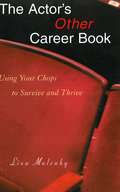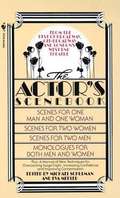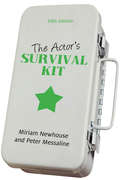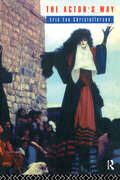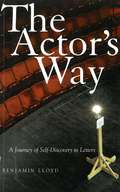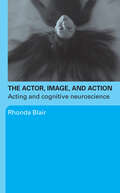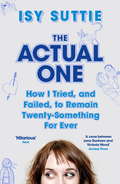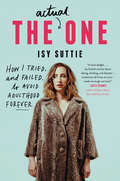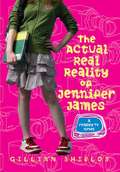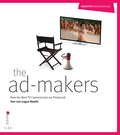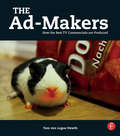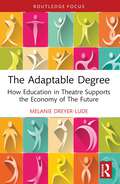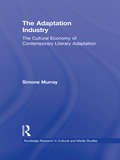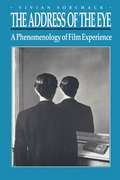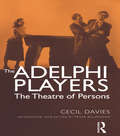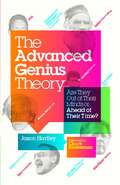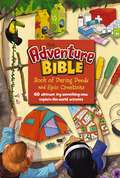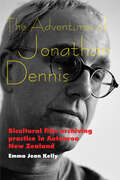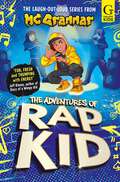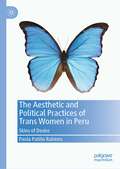- Table View
- List View
The Actor's Other Career Book: Using Your Chops to Survive and Thrive
by Lisa MulcahyActors don't have to become Broadway stars to make a living with their acting talents. The Actor's Other Career Book pulls back the curtain to reveal more than 50 permanent and temporary positions available in cruise ships, trade shows, retail stores, advertising agencies, corporate settings, education, social outreach, tourist attractions, physical fitness, and much more. Whether actors are looking to continue performing in new venues or apply their skills to a new field, this is the resource to help make the transition. Interviews with successful actors reveal how others looked beyond the stage for lucrative and satisfying work, how they applied their training and background to their current positions, and how they achieved success on their own terms. A comprehensive listing of organizations, Web sites, companies, and publications provide a wealth of tools. All actors looking to take control of their futures will need this book.
The Actor's Scenebook
by Michael Schulman Eva MeklerHere is wonderful, up-to-date material for scene study, selected from the best plays from recent theater seasons. More than 20 monologues for both men and women, carefully chosen to display the widest range of dramatic ability, are essential for auditioning actors. A large selection of parts for woman provide exciting opportunities to sharpen acting skills in roles that brought accolades from New York's toughest critics. More than 80 scenes in all, many previously unpublished, allow every actor, professional, amateur or student, to choose from either smart, sassy, often outrageous comedy or deeply moving drama--a unique, balanced collection of the most successful contemporary plays. 84 fully playable scenes with story notes. Monologues from the best new plays--including Agnes of God, Sly Fox, Key Exchange and Nuts. The best contemporary selection of scenes for women--more than 50 in all.
The Actor's Secret: Techniques for Transforming Habitual Patterns and Improving Performance
by Betsy PolatinOffering revolutionary new training for the actor, The Actor's Secret teaches actors and performers how to incorporate the fundamentals of the Alexander Technique, Somatic Experiencing®, and Breathing Coordination in order to reduce performance anxiety and stress; improve stage presence, breathing, and vocal production; and restore well-being and healthy functioning. These three kinesthetic disciplines are designed to lead to profound change and healing through body-mind reeducation. Part I explains in detail the principles of the three techniques. A practical method for self-improvement and neuromuscular reeducation, the Alexander Technique focuses on changing inefficient habits of movement and patterns of tension that inhibit the ability to move easily. Breathing Coordination helps increase breathing capacity and awareness. A method for resolving emotional trauma, Somatic Experiencing® follows a process of tracking bodily sensations to restore vitality and health. Enhanced with over 100 instructive photos, Parts II and III present explorations and exercises that draw on elements of the three methods. Topics covered include the importance of presence and non-doing; the proper mechanics of vocalization and singing; the understanding of character and role; and the actor's journey from auditions to performance, including initial script preparation, rehearsal, monologue, and scene work. Developed by Betsy Polatin, a movement specialist and master lecturer at Boston University's College of Fine Arts, the book's exercises provide the actor with simple tools for exploring his or her acting work. Most techniques and self-help books teach a new way of "doing." The secret of this book lies in "non-doing." When the actor learns to first recognize and then suspend habitual patterns, he or she opens the door to deeper artistic choices. "I have worked with many fine Alexander Technique teachers over the years and Betsy Polatin is far and away one of the finest. Her touch, her instincts, and her knowledge are miraculous."--Andre Gregory, actor and director, My Dinner with Andre
The Actor's Survival Kit: Fifth Edition
by Miriam Newhouse Peter MessalineThe Actor’s Survival Kit is required reading in Canadian theatre schools and is a constant resource for its many readers across the country. This fifth edition gives actors fresh research from today’s experience, new lists of Canada-wide contacts, and input from success stories. It speaks to a new generation of artists, giving them an up-to-date guide to the business of acting. The book addresses a range of new issues: performer websites, video self-production, and sending rmand networking on the Internet. It also takes a fresh look at old ones: agents, self-promotion, and work opportunities for women and minorities. The authors learn by constantly talking to emerging artists about the problems they face in the business in Canada. Often those conversations begin with, "You wrote the book!" The authors are still receiving thanks from grateful artists who have been guided by this irreplaceable book over the years.
The Actor's Way
by Erik Exe ChristoffersenCan 'stage presence' be acquired? Why do some actors appear more dynamic in performance than others? In The Actors Way four experienced actors talk about the secrets and the practical realities of over twenty-five years of theatre training with Odin Teatret. Under the unique direction of Eugenio Barba, director of Odin Teatret, they have explored issues such as the connections between physical and mental work on stage, how to gain and control the spectator's attention, and intercultural performance techniques. The Actor's Way is a fascinating account of personal and professional development in the theatre. It will be vital reading for drama students and actors, but enjoyable and illuminating for anyone interested in the craft of acting.
The Actor's Way: A Journey of Self-Discovery in Letters
by Benjamin LloydThis is required reading for anyone passionate about the theater, acting, and the teaching of it. The struggles of a young actor, the actor/director relationship, the challenges of teaching art in universities, ageism, and techniques for teaching realistic acting are all communicated through a fictional series of letters between Andy, an anguished young New York City actor and Alice, his Quaker grade-school acting teacher.
The Actor, Image, and Action: Acting and Cognitive Neuroscience
by Rhonda BlairThe Actor, Image and Action is a 'new generation' approach to the craft of acting; the first full-length study of actor training using the insights of cognitive neuroscience. In a brilliant reassessment of both the practice and theory of acting, Rhonda Blair examines the physiological relationship between bodily action and emotional experience. In doing so she provides the latest step in Stanislavsky's attempts to help the actor 'reach the unconscious by conscious means'. Recent developments in scientific thinking about the connections between biology and cognition require new ways of understanding many elements of human activity, including: imagination emotion memory physicality reason. The Actor, Image and Action looks at how these are in fact inseparable in the brain's structure and function, and their crucial importance to an actor’s engagement with a role. The book vastly improves our understanding of the actor's process and is a must for any actor or student of acting.
The Actress: Hollywood Acting and the Female Star
by Karen HollingerThe Actress: Hollywood Acting and the Female Star investigates the contemporary film actress both as an artist and as an ideological construct. Divided into two sections, The Actress first examines the major issues in studying film acting, stardom, and the Hollywood actress. Combining theories of screen acting and of film stardom, The Actress presents a synthesis of methodologies and offers the student and scholar a new approach to these two subjects of study.
The Actual One: How I Tried, And Failed, To Avoid Adulthood Forever
by Isy Suttie‘Isy Suttie turns the painful process of growing-up into something laugh-out-loud funny, and for that I could kiss her’ – Bryony Gordon, author of THE WRONG KNICKERS
The Actual One: How I Tried, and Failed, to Avoid Adulthood Forever
by Isy SuttieA hilarious, razor-sharp debut memoir about the moment when you realize that your friends have all grown up and left you behind, for readers of Caitlin Moran’s How To Be A Woman, Jenny Lawson’s Let’s Pretend This Never Happened, and Kelly Williams Brown’s Adulting.Isy Suttie wakes up one day in her late twenties to discover that the deal she’d struck with her friends, to put off growing up for as long as possible, had been entirely in her head. Everyone around her is suddenly into mortgages, farmers’ markets, and going off the Pill, rather than running naked into the sea or getting hammered in a country pub with eighty-year-old men.After a particularly crushing breakup precipitated by Isy’s gifting of a human-size papier-mâché penguin to her boyfriend, her dearest friend advises Isy not to worry: the next guy she meets will be The Actual One.Heartened by this promise, Isy decides to keep delaying the onset of adulthood, whether that means standing on the side of a highway in nothing but an old fur coat and sneakers, dating a man who speaks only in rhyme, or conquering her fears of Alpine skiing by wildly overestimating her athletic ability. Insightful and laugh-out-loud funny, The Actual One is an ode to the confusing wilderness of your late twenties, alongside a quest for a genuinely good relationship . . . or at the very least, a good story to tell.
The Actual One: How I tried, and failed, to remain twenty-something for ever
by Isy SuttieIsy woke up one day in her late twenties to discover that the invisible deal she'd done with her best mates - that they'd prolong growing up for as long as possible - had all been in her head. Everyone around her is suddenly into mortgages, farmers' markets and nappies, rather than the idea of running naked into the sea or getting hammered in Plymouth with eighty-year-old men. When her dearest friend advises her that the next guy Isy meets will be The Actual One, Isy decides to keep delaying the onset of adulthood - until a bet with her mother results in a mad scramble to find a boyfriend within a month.From papier-mâché penguins to being stranded on a dual carriageway in nothing but a fur coat and trainers, THE ACTUAL ONE is an ode to the confusing wilderness of your late twenties, alongside a quest for a genuinely good relationship with a man who doesn't use moisturiser.
The Actual One: How I tried, and failed, to remain twenty-something for ever
by Isy SuttieIsy woke up one day in her late twenties to discover that the invisible deal she'd done with her best mates - that they'd prolong growing up for as long as possible - had all been in her head. Everyone around her is suddenly into mortgages, farmers' markets and nappies, rather than the idea of running naked into the sea or getting hammered in Plymouth with eighty-year-old men. When her dearest friend advises her that the next guy Isy meets will be The Actual One, Isy decides to keep delaying the onset of adulthood - until a bet with her mother results in a mad scramble to find a boyfriend within a month.From papier-mâché penguins to being stranded on a dual carriageway in nothing but a fur coat and trainers, THE ACTUAL ONE is an ode to the confusing wilderness of your late twenties, alongside a quest for a genuinely good relationship with a man who doesn't use moisturiser.Performed by Isy Suttie, and featuring three songs from the book. This audio edition also includes an exclusive extra song and a unique introduction.(p) 2016 Orion Publishing Group
The Actual Real Reality of Jennifer James
by Gillian ShieldsThis is the diary of Jennifer James. It contains: One Heroine: Jennifer James, burdened by brains, struggling to release her Inner Babe One High School: London Road Comprehensive, a no-hope English school in a no-hope English town One Prize: A scholarship to the elite St. Willibald's College [Jennifer's idea of Paradise] offered to the winner of a tacky reality TV show, Down The Bog and . . . A Thousand Complications: Like Jocasta, the crazy feminist mother; Tallulah, the blond rival from hell; Marcus, the guy with green eyes; and above all, the actual real reality that Jennifer's chances of winning are less than Mega-Zero. . . .
The Ad Makers: How the Best TV Commercials are Produced
by Tom von NewthThe Ad-Makers looks at the cinematic form where commerce and creativity collide most dramatically: the TV commercial.Featuring interviews from top professionals in the field, the book provides the kind of behind-the-scenes expertise that it usually takes a lifetime of professional practice to acquire.Gathered from the disciplines of cinematography, directing, producing and editing, the filmmakers tell the stories behind the making of some of the world's top commercials. Each chapter includes an overview of best practice and a host of images-stills from the spots themselves and concept visuals.Exploring the creative process from conception to post-production, The Ad-Makers also covers developments within the industry precipitated by the digital age and the new challenges placed on ad-making by the explosion of social media.With special focus on the shooting and production elements of making a television advert, this book is ideal for all filmmakers who want to build a career in advertising, or, as is increasingly common, feature films.- The stories behind some of the best-known TV commercials, as told by the people who made them- Top producers, designers, storyboarders, directors, editors and visual effects creatives reveal the secrets of the television advertising industry
The Ad-Makers: How the Best TV Commercials are Produced (Creative Professional Ser.)
by Tom von Logue NewthThe Ad-Makers looks at the cinematic form where commerce and creativity collide most dramatically: the TV commercial. Featuring interviews from top professionals in the field, the book provides the kind of behind-the-scenes expertise that it usually takes a lifetime of professional practice to acquire. Gathered from the disciplines of cinematography, directing, producing, and editing, the filmmakers tell the stories behind the making of some of the world’s top commercials. Each chapter includes an overview of best practice and a host of images—stills from the spots themselves and concept visuals. Exploring the creative process from conception to post-production, The Ad-Makers also covers developments within the industry precipitated by the digital age and the new challenges placed on ad-making by the explosion of social media. With special focus on the shooting and production elements of making a television advert, this book is ideal for all filmmakers who want to build a career in advertising or even feature films. • The stories behind some of the best-known TV commercials, as told by the people who made them • Top producers, designers, storyboarders, directors, editors, and visual effects creatives reveal the secrets of the television advertising industry
The Adaptable Degree: How Education in Theatre Supports the Economy of The Future (ISSN)
by Melanie Dreyer-LudeThis book utilized a mixed-methods research study of the career experiences of theatre graduates in the U.S. to provide data on employment patterns and job satisfaction.With a population of over 1,000 participants, this study examined where graduates were working, how their careers had changed over time, which skills acquired with their theatre degree were being used in current employment, and whether they believed their course of study was worth the financial investment, given their current circumstances. Evidence from this study revealed that a theatre degree provided many of the skills the employment market is currently seeking and that theatre graduates were gainfully employed in multiple sectors of the economy.This important data-based, field-specific information will aid chairs, deans, provosts, politicians, students and parents in deicision-making at a time when arts and humanities departments across the country are under the threat of elimination.
The Adaptation Industry: The Cultural Economy of Contemporary Literary Adaptation (Routledge Research in Cultural and Media Studies)
by Simone MurrayAdaptation constitutes the driving force of contemporary culture, with stories adapted across an array of media formats. However, adaptation studies has been concerned almost exclusively with textual analysis, in particular with compare-and-contrast studies of individual novel and film pairings. This has left almost completely unexamined crucial questions of how adaptations come to be made, what are the industries with the greatest stake in making them, and who the decision-makers are in the adaptation process. The Adaptation Industry re-imagines adaptation not as an abstract process, but as a material industry. It presents the adaptation industry as a cultural economy of six interlocking institutions, stakeholders and decision-makers all engaged in the actual business of adapting texts: authors; agents; publishers; book prize committees; scriptwriters; and screen producers and distributors. Through trading in intellectual property rights to cultural works, these six nodal points in the adaptation network are tightly interlinked, with success for one party potentially auguring for success in other spheres. But marked rivalries between these institutional forces also exist, with competition characterizing every aspect of the adaptation process. This book constructs an overdue sociology of contemporary literary adaptation, never losing sight of the material and institutional dimensions of this powerful process.
The Address of the Eye: A Phenomenology of Film Experience
by Vivian SobchackCinema is a sensuous object, but in our presence it becomes also a sensing, sensual, sense-making subject. Thus argues Vivian Sobchack as she challenges basic assumptions of current film theory that reduce film to an object of vision and the spectator to a victim of a deterministic cinematic apparatus. Maintaining that these premises ignore the material and cultural-historical situations of both the spectator and the film, the author makes the radical proposal that the cinematic experience depends on two "viewers" viewing: the spectator and the film, each existing as both subject and object of vision. Drawing on existential and semiotic phenomenology, and particularly on the work of Merleau-Ponty, Sobchack shows how the film experience provides empirical insight into the reversible, dialectical, and signifying nature of that embodied vision we each live daily as both "mine" and "another's." In this attempt to account for cinematic intelligibility and signification, the author explores the possibility of human choice and expressive freedom within the bounds of history and culture.
The Adelphi Players: The Theatre of Persons
by Dr Cecil DaviesCecil Davies' The Adelphi Players: The Theatre of Persons represents a uniquely interesting contribution to our understanding of touring British theatre in the mid-twentieth-century, post-war period. This book will interest everyone - whether student, academic or general reader - who wants to know more about issues concerning the recent history of British theatre. In their values and aims, the Adelphi Players pre-empted many of the post-war developments that we associate with the non-commercial, fringe and community theatre movement. In Richard Heron Ward founder of the Adelphi-Players, we encounter a dramatist, novelist, essayist and poet who has been unusually neglected in terms of our appreciation of the English literature of the broad left in the 1930s, `40s and `50s. The Adelphi Players has been edited by Peter Billingham, who has also provided an introduction placing Ward and the Adelphi players in the wider social, cultural and ideological context.
The Advanced Genius Theory: Are They Out of Their Minds or Ahead of Their Time?
by Jason HartleyLet the debate begin The Advanced Genius Theory, hatched by Jason Hartley and Britt Bergman over pizza, began as a means to explain why icons such as Lou Reed, David Bowie, and Sting seem to go from artistic brilliance in their early careers to "losing it" as they grow older. The Theory proposes that they don't actually lose it, but rather, their work simply advances beyond our comprehension. The ramifications and departures of this argument are limitless, and so are the examples worth considering, such as George Lucas's Jar Jar Binks, Stanley Kubrick's fascination with coffee commercials, and the last few decades of Paul McCartney's career. With equal doses of humor and philosophy, theorist Jason Hartley examines music, literature, sports, politics, and the very meaning of taste, presenting an entirely new way to appreciate the pop culture we love . . . and sometimes think we hate. The Advanced Genius Theory is a manifesto that takes on the least understood work by the most celebrated figures of our time.
The Adventure Bible Book of Daring Deeds and Epic Creations: 60 ultimate try-something-new, explore-the-world activities (Adventure Bible)
by ZondervanBegin your adventure here! The Adventure Bible Book of Daring Deeds and Epic Creations: 60 Ultimate Try-Something-New, Explore-the-World Activities contains lessons on knot tying, writing coded letters, building tree swings, and more, perfect for kids ages 8 and up. Boys and girls will love this interactive book filled with step-by-step guides and fun, full-color illustrations, and parents will enjoy the key verses and biblical takeaways that make this the perfect companion to the NIV Adventure Bible, the #1 Bible for kids. From easy, do-it-yourself crafts to fun outdoor activities, this book will show kids how to find adventure indoors and out.Adventures include:Top-secret coded lettersGeocaching funIdentifying animal tracksCamping like a proLearning sign languageBible arts and craftsAnd more!
The Adventures of Grandmaster Flash: My Life, My Beats
by David Ritz Grandmaster FlashA no-holds-barred memoir from the primary architect of hip hop and one of the culture's most revered music icons--both the tale of his life and legacy and a testament to dogged determination. Grandmaster Flash and the Furious Five fomented the musical revolution known as hip hop. Theirs was a groundbreaking union between one DJ and five rapping MCs. One of the first hip hop posses, they were responsible for such masterpieces as "The Message" and "Adventures of Grandmaster Flash on the Wheels of Steel. " In the 1970s Grandmaster Flash pioneered the art of break-beat DJing--the process of remixing and thereby creating a new piece of music by playing vinyl records and turntables as musical instruments. Disco-era DJs spun records so that people could dance. The original turntablist, Flash took it a step further by cutting, rubbing, backspinning, and mixing records, focusing on "breaks"--what Flash described as "the short, climactic parts of the records that really grabbed me"--as a way of heightening musical excitement and creating something new. Now the man who paved the way for such artists as Jay-Z, Sean "P. Diddy" Combs, and 50 Cent tells all--from his early days on the mean streets of the South Bronx, to the heights of hip hop stardom, losing millions at the hands of his record label, his downward spiral into cocaine addiction, and his ultimate redemption with the help and love of his family and friends. In this powerful memoir, Flash recounts how music from the streets, much like rock 'n' roll a generation before, became the sound of an era and swept a nation with its funk, flavor, and beat.
The Adventures of Jonathan Dennis: Bicultural Film Archiving Practice in Aotearoa New Zealand
by Emma Jean KellyJonathan Dennis (1953-2002), was the creative and talented founding director of the New Zealand Film Archive. As a Pakeha (non-Maori/indigenous New Zealander) with a strong sense of social justice, Dennis became a conduit for tension and debate over the preservation and presentation of indigenous and non-indigenous film archival materials from the time the Archive opened in 1981. His work resulted in a film archive and curatorship practice which differed significantly from that of the North American and European archives he originally sought to emulate. He supported a philosophical shift in archival practice by engaging indigenous peoples in developing creative and innovative exhibitions from the 1980s until his death, recognizing that much of the expertise required to work with archival materials rested with the communities outside archival walls. This book presents new interviews gathered by the author, as well as an examination of existing interviews, films and broadcasts about and with Jonathan Dennis, to consider the narrative of a life and work in relation to film archiving.
The Adventures of Rap Kid: A hilarious, high-energy new series from the viral rapping social media sensation
by MC Grammar'FUN, FRESH and THUMPING with ENERGY' - Jeff Kinney, bestselling author of Diary of a Wimpy Kid The first in a hilarious series from multi-award-winning teacher and World Book Day Ambassador, MC Grammar! Meet Z, he only speaks in rhyme. Teased all the time. But now it&’s his time to shine. Z stands for ZERO: being the amount of words that Z speaks at school. Why? Because every time he talks, it rhymes. Every. Single. Time. But, things are about to change. The Royal Rap Rumble is coming to town in search of the next rhyming rap legend. With the help of his super-cool English teacher, Mr G, his best friend, SFX, and the ultimate hip-hop makeover, RAP KID is born. But can he become the G.O.A.T and take home the golden mic? Bring on the vibes! The Adventures of Rap Kid celebrates the power of words and friendship.Perfect for fans of Diary of a Wimpy Kid, Tom Gates and Loki.From the viral book-rapping sensation and star of SkyKids Wonder Raps and Rap Tales.
The Aesthetic and Political Practices of Trans Women in Peru: Skins of Desire
by Paola Patiño RabinesThis book explores the political-aesthetic practices of transgender women in Lima, Peru, and how they use these to survive and fight for recognition and full citizenship, through drawing on ethnographic research and on decolonial feminist and aesthetic theories. Chapters analyze how the vulnerability and precariousness of trans women coexist with modes of feminist agency, resistance and resilience, as well as with proposals for political action to transform a heteropatriarchal society toward a more diverse and accepting one. Finally, the author draws on the Viennese artist Friedensreich Hundertwasser’s metaphor of the five skins, whereby the first skin is the epidermis; the second is the clothes; the third is the house; the fourth is identity, which refers to primary socialization spaces such as the neighbourhood; and the fifth is the world environment. The author uses this metaphor to analyze the corporal practices of trans women in a cumulative way, paying special attention to the different stages of their lives, to those skins that embody and accompany them from childhood to adulthood.This book will be of interest to scholars of transgender studies, decolonial feminist studies, and aesthetic, particularly those with a focus on gender and sexuality in Latin America.
